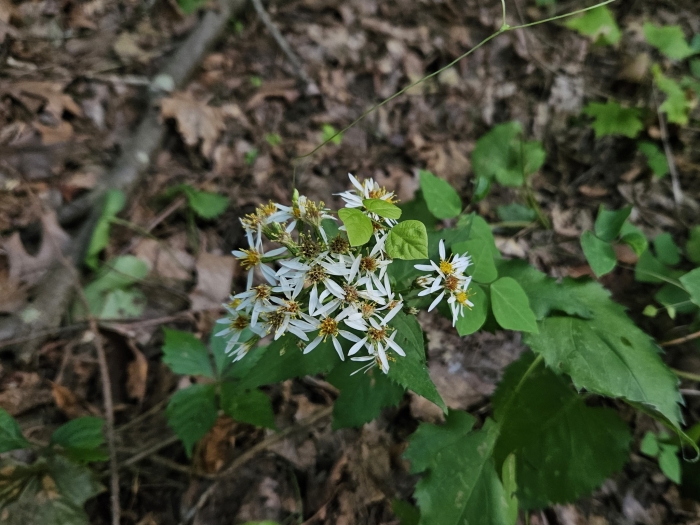Schreber’s Aster
(Eurybia schreberi)
Schreber’s Aster (Eurybia schreberi)
/
/

Daniel McClosky
CC BY 4.0
Image By:
Daniel McClosky
Recorded By:
Copyright:
CC BY 4.0
Copyright Notice:
Photo by: Daniel McClosky | License Type: CC BY 4.0 | License URL: http://creativecommons.org/licenses/by/4.0/ | Rights Holder: Daniel McClosky | Publisher: iNaturalist | Date Created: 2023-08-03T19:03:50-07:00 |

























Estimated Native Range
Summary
Eurybia schreberi, commonly known as Schreber’s aster or nettle-leaved Michaelmas-daisy, is a perennial herb that is indigenous to eastern North America, specifically in regions of Canada and the United States. It is typically found in the understory of mesic to moist deciduous forests, often alongside maple, elm, or oak trees, and can also be seen in thickets and along shaded roadbanks. Eurybia schreberi thrives at elevations up to 3937 feet. This plant is characterized by its late summer to early fall blooming period, showcasing white ray florets surrounding a center of yellow disc florets. The flowers are modest in size but can add a delicate beauty to woodland gardens.
In cultivation, Schreber’s aster is valued for its late-season blooms and its ability to thrive in shaded conditions, making it a suitable choice for woodland gardens and shaded borders. It is also appreciated for its resilience in moist soil conditions and its relatively low maintenance requirements once established. Gardeners often use it to provide late-season color and to support pollinators. While it is not commonly reported to have significant disease or pest issues, it can be susceptible to powdery mildew in overly humid conditions. It is important to note that Eurybia schreberi is endangered in Indiana and Iowa and of special concern in Tennessee, indicating that its natural populations are under threat.CC BY-SA 4.0
In cultivation, Schreber’s aster is valued for its late-season blooms and its ability to thrive in shaded conditions, making it a suitable choice for woodland gardens and shaded borders. It is also appreciated for its resilience in moist soil conditions and its relatively low maintenance requirements once established. Gardeners often use it to provide late-season color and to support pollinators. While it is not commonly reported to have significant disease or pest issues, it can be susceptible to powdery mildew in overly humid conditions. It is important to note that Eurybia schreberi is endangered in Indiana and Iowa and of special concern in Tennessee, indicating that its natural populations are under threat.CC BY-SA 4.0
Plant Description
- Plant Type: Herb
- Height: 1.5-2.5 feet
- Width: 1-3 feet
- Growth Rate: Moderate
- Flower Color: White
- Flowering Season: Summer, Fall
- Leaf Retention: Deciduous
Growth Requirements
- Sun: Part Shade, Full Shade
- Water: Medium
- Drainage: Medium, Slow
Common Uses
Border Plant, Butterfly Garden, Low Maintenance, Water Garden
Natural Habitat
Understory of mesic to moist deciduous forests, often alongside maple, elm, or oak trees
Other Names
Common Names: Schreber’s Wood Aster, Northern Aster
Scientific Names: , Eurybia schreberi, Aster curvescens, Aster curvescens var. curvescens, Aster curvescens var. oviformis, Aster curvescens var. umbelliformis, Aster glomeratus, Aster glomeratus, Aster glomeratus, Aster macrophyllus var. schreberi
GBIF Accepted Name: